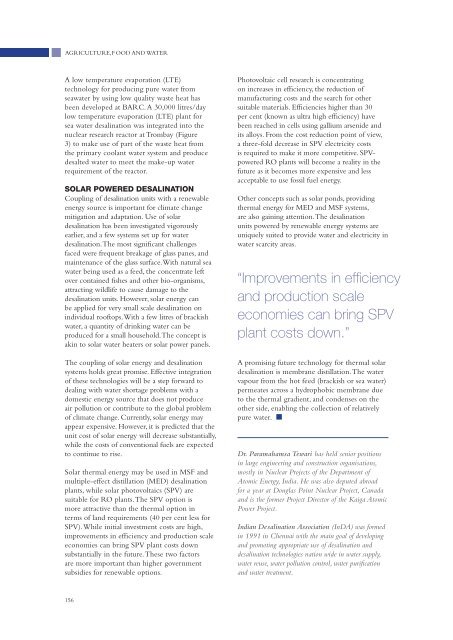Climate Action 2012-2013
Create successful ePaper yourself
Turn your PDF publications into a flip-book with our unique Google optimized e-Paper software.
AGRICULTURE, FOOD AND WATER<br />
A low temperature evaporation (LTE)<br />
technology for producing pure water from<br />
seawater by using low quality waste heat has<br />
been developed at BARC. A 30,000 litres/day<br />
low temperature evaporation (LTE) plant for<br />
sea water desalination was integrated into the<br />
nuclear research reactor at Trombay (Figure<br />
3) to make use of part of the waste heat from<br />
the primary coolant water system and produce<br />
desalted water to meet the make-up water<br />
requirement of the reactor.<br />
SOLAR POWERED DESALINATION<br />
Coupling of desalination units with a renewable<br />
energy source is important for climate change<br />
mitigation and adaptation. Use of solar<br />
desalination has been investigated vigorously<br />
earlier, and a few systems set up for water<br />
desalination. The most significant challenges<br />
faced were frequent breakage of glass panes, and<br />
maintenance of the glass surface. With natural sea<br />
water being used as a feed, the concentrate left<br />
over contained fishes and other bio-organisms,<br />
attracting wildlife to cause damage to the<br />
desalination units. However, solar energy can<br />
be applied for very small scale desalination on<br />
individual rooftops. With a few litres of brackish<br />
water, a quantity of drinking water can be<br />
produced for a small household. The concept is<br />
akin to solar water heaters or solar power panels.<br />
The coupling of solar energy and desalination<br />
systems holds great promise. Effective integration<br />
of these technologies will be a step forward to<br />
dealing with water shortage problems with a<br />
domestic energy source that does not produce<br />
air pollution or contribute to the global problem<br />
of climate change. Currently, solar energy may<br />
appear expensive. However, it is predicted that the<br />
unit cost of solar energy will decrease substantially,<br />
while the costs of conventional fuels are expected<br />
to continue to rise.<br />
Solar thermal energy may be used in MSF and<br />
multiple-effect distillation (MED) desalination<br />
plants, while solar photovoltaics (SPV) are<br />
suitable for RO plants. The SPV option is<br />
more attractive than the thermal option in<br />
terms of land requirements (40 per cent less for<br />
SPV). While initial investment costs are high,<br />
improvements in efficiency and production scale<br />
economies can bring SPV plant costs down<br />
substantially in the future. These two factors<br />
are more important than higher government<br />
subsidies for renewable options.<br />
Photovoltaic cell research is concentrating<br />
on increases in efficiency, the reduction of<br />
manufacturing costs and the search for other<br />
suitable materials. Efficiencies higher than 30<br />
per cent (known as ultra high efficiency) have<br />
been reached in cells using gallium arsenide and<br />
its alloys. From the cost reduction point of view,<br />
a three-fold decrease in SPV electricity costs<br />
is required to make it more competitive. SPVpowered<br />
RO plants will become a reality in the<br />
future as it becomes more expensive and less<br />
acceptable to use fossil fuel energy.<br />
Other concepts such as solar ponds, providing<br />
thermal energy for MED and MSF systems,<br />
are also gaining attention. The desalination<br />
units powered by renewable energy systems are<br />
uniquely suited to provide water and electricity in<br />
water scarcity areas.<br />
“Improvements in efficiency<br />
and production scale<br />
economies can bring SPV<br />
plant costs down.”<br />
A promising future technology for thermal solar<br />
desalination is membrane distillation. The water<br />
vapour from the hot feed (brackish or sea water)<br />
permeates across a hydrophobic membrane due<br />
to the thermal gradient, and condenses on the<br />
other side, enabling the collection of relatively<br />
pure water. <br />
Dr. Paramahamsa Tewari has held senior positions<br />
in large engineering and construction organisations,<br />
mostly in Nuclear Projects of the Department of<br />
Atomic Energy, India. He was also deputed abroad<br />
for a year at Douglas Point Nuclear Project, Canada<br />
and is the former Project Director of the Kaiga Atomic<br />
Power Project.<br />
Indian Desalination Association (InDA) was formed<br />
in 1991 in Chennai with the main goal of developing<br />
and promoting appropriate use of desalination and<br />
desalination technologies nation wide in water supply,<br />
water reuse, water pollution control, water purification<br />
and water treatment.<br />
156












